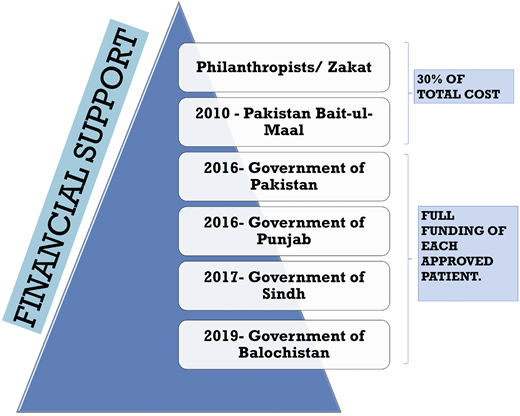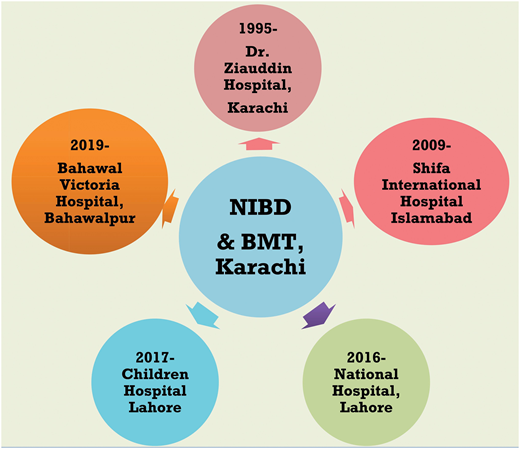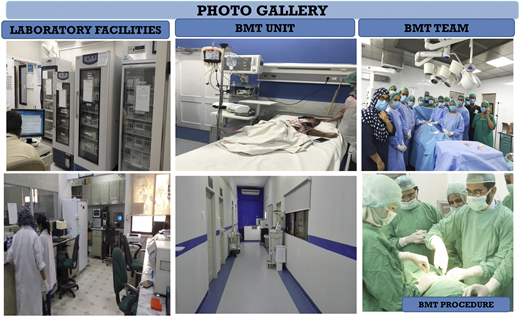Background
Pakistan belongs to the low- or middle-income countries, is divided into 4 provinces, and has a population of 208 million people. Only 5% of the annual national budget is reserved for health care facilities. The average income is US$1,000 per year. Of the hematologic diseases that affect our population, β thalassemia major (BTM) and acquired aplastic anemia (AA) are the most prevalent followed by acute leukemia. An estimated 5000 to 9000 children are born each year with BTM, although no registry is available in Pakistan to document the numbers. The only curative treatment for these disorders is hematopoietic stem cell transplantation (HSCT).
At a minimum, Pakistan needs 100 bone marrow transplantation (BMT) centers in private and public sectors in the 4 provinces to meet the current requirement for ∼10 000 transplantations per year. The National Institute of Blood Diseases and Bone Marrow Transplantation (NIBD & BMT) team pioneered BMT in 1995 at Dr. Ziauddin Hospital in Karachi. The team took responsibility for training human resources to staff the BMT units and for developing BMT units in public and private-sector hospitals so the maximum number of patients can receive treatment at an affordable cost.
Currently, only matched related donor transplants are performed. Alternative donor programs are nonexistent. There is no national donor registry, and there is no access to umbilical cord blood stem cells from within the country. In general, family size is large, which is helpful in providing a matched related donor (eg, siblings, parents, and extended family members) in almost half of all cases. There is a dire need to establish a marrow donor registry and a cord blood bank. Haploidentical family donor transplantations were begun in 2014.
A national outcome registry is another important aspect currently unavailable in Pakistan. The Human Organ Transplant Authority (HOTA) is the regulatory body that oversees the functioning of the transplantation centers and helps optimize the availability of human resources needed to operate the centers.
Objectives
Current objectives include:
Establishing BMT facilities in all provincial capitals of Pakistan,
Facilitating access to BMT facilities near the patient’s residence,
Training health care professionals in BMT, and
Facilitating funding from the government of Pakistan to help BMT patients cover the costs of transplantation.
Capacity building
Capacity building focuses on training and recruiting health care professionals and other essential human resources.
Physicians
Tahir S. Shamsi received BMT training under the mentorship of Steve Schey at Guy’s Hospital (London, United Kingdom) who also provided guidance during the initial years of the BMT program in Pakistan.
Tasneem Farzana received training and became affiliated with Guy’s Hospital (London, United Kingdom).
Uzma Zaidi received training and became affiliated with MD Anderson Cancer Center (Houston, TX).
Nurses
Nurses received training at Guy’s Hospital (London, United Kingdom) for BMT and then trained other nurses upon returning to Pakistan.
The infection control team received training locally.
Twelve nurses have been trained so far.
In addition to physicians and nurses, more than 25 staff have been trained in stem cell, molecular, and hematology laboratory skills; 4 technicians have been trained to perform apheresis, and more than 12 blood banking technologists have been trained.
Financial support for equipment and patient care.
The combined efforts of Tahir S. Shamsi and various philanthropists resulted in the acquisition of apheresis and cryopreservation equipment for allogeneic and autologous transplantation for NIBD & BMT (Karachi), National Hospital (Lahore), Children’s Hospital (Lahore), Bahawal Victoria Hospital (Bahawalpur), and Shifa International Hospital (Islamabad). Molecular laboratories for diagnosing infections resulting from transplantations have been established, in addition to laboratories that are able to perform HLA typing and assess donor chimerism. The availability and supply of irradiated blood components in the blood banks are now guaranteed. Figure 1 shows the financial support provided to patients across the country for BMT.
Joint ventures involving public and private-sector hospitals.
In 2009, Shifa International Hospital (Islamabad) asked for help during the initial phase of its BMT program.
In 2015, the National Hospital (Lahore) asked for help from NIBD in forming a joint venture that would help establish a BMT unit and develop protocols for harvesting stem cells and for cryopreservation.
In 2016, the government of Punjab asked the NIBD to help establish BMT units at the Children’s Hospital and the Institute of Child Health (Lahore).
In 2017, the government of Punjab again asked NIBD to help establish a BMT unit at the Bahawal Victoria Hospital (Bahawalpur).
Figure 2 shows the timeline for establishing the different BMT centers. Tahir S. Shamsi was appointed as the honorary convenor and director of the BMT program. Table 1 provides the annual capacity of individual centers to perform BMTs. Table 2 provides common indications for performing BMTs in Pakistan. Note that the majority of BMTs performed are allogeneic for benign disorders. Figure 3 shows the transplantation outcomes of patients at these BMT centers. Figure 4 provides a glimpse of various BMT units.
Timeline of NIBD efforts to help public and private-sector hospitals establish BMT units.
Timeline of NIBD efforts to help public and private-sector hospitals establish BMT units.
Annual capacity for performing BMT
| BMT units . | Expected no. of BMTs per year . |
|---|---|
| NIBD (Karachi) | 60-70 |
| Shifa International Hospital (Islamabad) | 30-32 |
| Children’s Hospital (Lahore) | 18-20 |
| National Centre of Blood Diseases (Lahore) | 12-14 |
| Bahawal Victoria Hospital (Bahawalpur) | 60-70 |
| BMT units . | Expected no. of BMTs per year . |
|---|---|
| NIBD (Karachi) | 60-70 |
| Shifa International Hospital (Islamabad) | 30-32 |
| Children’s Hospital (Lahore) | 18-20 |
| National Centre of Blood Diseases (Lahore) | 12-14 |
| Bahawal Victoria Hospital (Bahawalpur) | 60-70 |
Number of BMTs performed up to mid-2017 in BMT centers
| Variables . | NIBD (Karachi) . | National Centre of Blood Diseases (Lahore) . | Children’s Hospital (Lahore) . | Shifa International Hospital (Islamabad) . |
|---|---|---|---|---|
| Indications for BMT | ΒΤΜ, AA, Fanconi anemia, acute myeloid leukemia, acute lymphoblastic leukemia, lymphoma, myeloma, primary immune deficiency disorders | ΒΤΜ, AA, lymphoma | ΒΤΜ, AA | ΒΤΜ, AA, Fanconi anemia, acute myeloid leukemia, acute lymphoblastic leukemia, lymphoma, myeloma, primary immune deficiency disorders |
| No. of BMTs | ||||
| Allogeneic | 634 | 14 | 17 | 54 |
| Autologous | 56 | 2 | 0 | 46 |
| Variables . | NIBD (Karachi) . | National Centre of Blood Diseases (Lahore) . | Children’s Hospital (Lahore) . | Shifa International Hospital (Islamabad) . |
|---|---|---|---|---|
| Indications for BMT | ΒΤΜ, AA, Fanconi anemia, acute myeloid leukemia, acute lymphoblastic leukemia, lymphoma, myeloma, primary immune deficiency disorders | ΒΤΜ, AA, lymphoma | ΒΤΜ, AA | ΒΤΜ, AA, Fanconi anemia, acute myeloid leukemia, acute lymphoblastic leukemia, lymphoma, myeloma, primary immune deficiency disorders |
| No. of BMTs | ||||
| Allogeneic | 634 | 14 | 17 | 54 |
| Autologous | 56 | 2 | 0 | 46 |
Outcomes for patients who received BMTs. CHL, Children’s Hospital (Lahore); Cum., cumulative; NHL, National Hospital Lahore (Lahore); SIH, Shifa International Hospital (Islamabad).
Outcomes for patients who received BMTs. CHL, Children’s Hospital (Lahore); Cum., cumulative; NHL, National Hospital Lahore (Lahore); SIH, Shifa International Hospital (Islamabad).
Associations.
The professionals of NIBD are permanent members of these societies:
ASBMT, American Society for Bone Marrow Transplantation,
EBMT, European Society for Blood and Marrow Transplantation,
ASH, American Society of Hematology, and
EHA, European Hematology Association.
Publications.
A total of 13 articles relating to BMT at our centers have been published in journals that have a high impact factor.
Conclusion
The management and outcome of patients with various hematologic disorders have been remarkably improved with the advent of BMT services developed by the joint efforts of NIBD and the government of Pakistan. There is a gross disparity between the need for BMT services and the current capacity to perform these procedures. In the next few years, the number of transplantations per year is expected to increase with the availability of more human resources and more funding from the government.
Acknowledgments
The authors thank the patients, their families, health care personnel, laboratory technicians, and all of those involved in the BMT process for their support.
This work was supported by the Government of Pakistan and the provincial governments of Punjab, Sindh, and Balochistan.
Authorship
Conflict-of-interest disclosure: The authors declare no competing financial interests.
Correspondence: Tahir S. Shamsi, National Institute of Blood Diseases and Bone Marrow Transplantation, ST 2/A Block 17 Gulshan-e-Iqbal, KDA Scheme 24, Karachi 74300, Pakistan; e-mail: tahir.shamsi@nibd.edu.pk.




